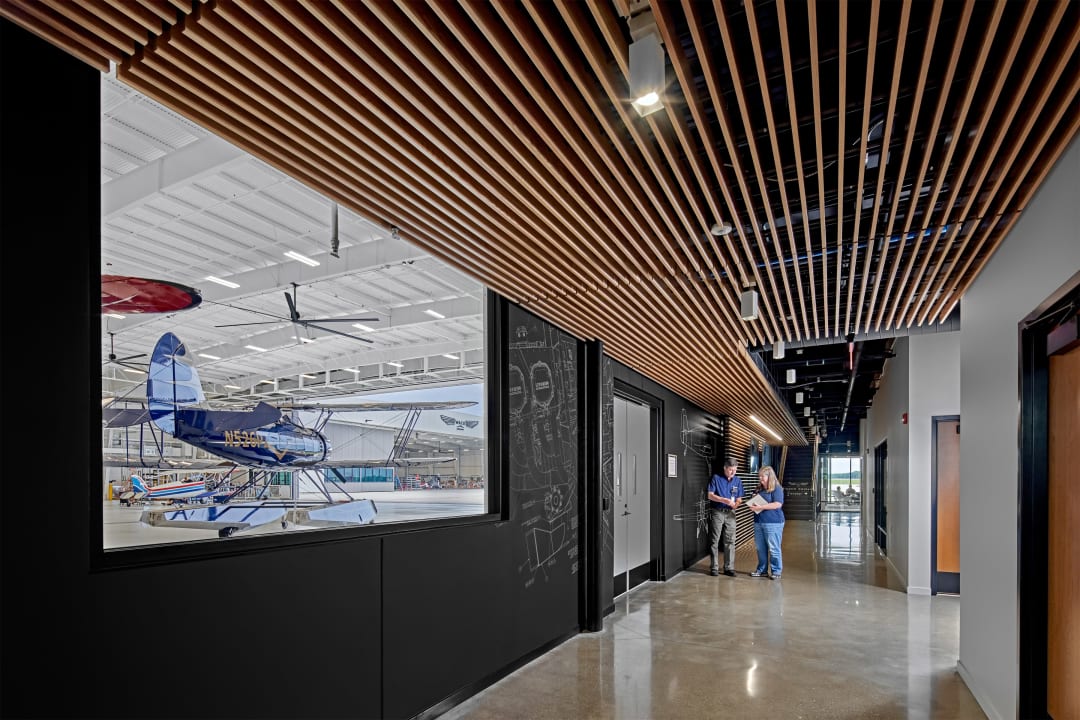3 strategies to optimize energy efficiency when designing steel buildings
Published: September 11, 2023

Waco Aircraft Corp. Project size: 66,300 square feet. Products used: Continuous beam frame. SSR Roof System. ThermaClad Wall System. Completed with global architectural firm Ghafari and Pioneer Construction.
AIA partner BlueScope Buildings North America offers expert strategies that aim to help reduce carbon emissions and enhance energy efficiency in low-rise, steel commercial buildings.
Energy efficiency and decarbonization are on everyone’s mind these days. Architects, engineers, builders — we all know the environmental and business reasons why commercial buildings need to become more efficient.

Twin Rivers Charter School campus, 49,876 square feet, designed by Swift Lee Office Architect.
From sports facilities and airplane hangars to sleek office spaces (and everything in between), commercial structures account for around 20% of the energy consumption in the United States. And the built environment is responsible for 40% of global greenhouse gas emissions.
No wonder the AIA 2030 Commitment aims to reach carbon neutrality in just seven years.
“Architects can’t reach net-zero on their own,” said Dan Kumm, senior director of business insights at BlueScope Buildings. Forming partnerships across industries and areas of expertise can unleash more innovative processes and drive greater efficiency throughout construction and the full life-cycle of a building.
(A recent BlueScope Buildings innovation accelerator demonstrated this, with the launch of five new pilot programs designed to revolutionize the construction industry.)
Kumm says that when architects are designing steel exteriors, applying these efficiencies requires three distinct approaches to the building process.
1. Track supply chain to ensure optimized materials
To ensure you’re getting the most efficient end-product, you need eyes on the supply chain from end-to-end, Kumm said. “To get a low-carbon solution, you have to get down to supplier-specific knowledge — where the raw material was first sourced and how much embodied carbon was accumulated along the journey to the final product stage."
Like-minded suppliers who are making significant efforts to invest in sustainable solutions and have the options available to achieve energy efficiencies can be critical to meeting project-specific goals.
“The best way for a design team to gain supply chain visibility is to engage suppliers who can track their sub-suppliers, through every step of material sourcing and production,” Kumm advised.
For architects who want to begin having this conversation with suppliers, consider starting with a steel fabricator’s mill test report (MTR).

Club Internacional de Fútbol Miami. Project Size: 54,600 square feet. Products used: Conventional steel frame.
2. Smart steel solutions reduce carbon emissions
“To work with steel more sustainably, it’s about putting steel where you need it and not where you don’t,” Kumm explained. “Optimize structural numbers to put steel where the loads are greatest.”
Designers can achieve the same aesthetic and integrity with less product by working closely with engineers and steel producers to determine the best product application for their specific project.
While steel is infinitely recyclable — which is great from a sustainability perspective — Kumm summed up the value of efficient material use: “One of the best things you can do for carbon reduction in a new build is to use less materials.”
Architects who would like to communicate the impact of smart steel solutions in concrete terms can use the EPA Greenhouse Gas Equivalencies calculator.
3. Early collaboration leads to more efficient design
Early collaboration makes it easier to form shared goals and “collectively deliver a low-carbon solution,” said Kumm.
“Partnering with suppliers up front to create trust and transparency is a good way to do this,” he suggested.
Ryan Hill, president of Varco Pruden Buildings, a leader in pre-engineered steel building systems, agreed early partnership is essential. A prime example of his team of engineers and other specialists working closely with architects from the very start of a project is the Waco Aircraft project, completed with global architectural firm Ghafari and Pioneer Construction.
There’s also an additional benefit to this collaborative approach: “Over the last 10 to 15 years, energy codes have become more stringent, and that trend will likely continue,” Hill explained. “As experts in how steel functions from a structural perspective, we can collaborate with the design team on alternative custom solutions.”

Powell Canada Inc. 123,000 full-service manufacturing facility designed by Bennett Architect, Inc.
Efficient steel solutions lead to long-term benefits
Today’s smart steel buildings can be as aesthetically appealing as they are strong and energy efficient.
Christen Funk, president of Butler Manufacturing, an industry leader and category innovator in pre-engineered metal solutions, said, “Steel exteriors might involve higher upfront costs, but ultimately enable savings, enhanced longevity, and increased sustainability, thanks to durability.”
The potential for steel buildings to be combined with further eco-friendly options, like solar panels and rainwater collection systems, adds to their appeal. Insulation techniques and deflective roofing commonly used for steel buildings also increase energy cost savings.
“When a project enables optimized teamwork, smart steel solutions, and better supply chain insight, the result is more energy-efficient buildings — as well as a healthier planet,” Funk continued.
Look for new CEUs exploring metal building systems in architectural design coming from BlueScope Buildings North America and its family of brands this fall.
AIA does not sponsor or endorse any enterprise, whether public or private, operated for profit. Further, no AIA officer, director, committee member, or employee, or any of its component organizations in his or her official capacity, is permitted to approve, sponsor, endorse, or do anything that may be deemed or construed to be an approval, sponsorship, or endorsement of any material of construction or any method or manner of handling, using, distributing, or dealing in any material or product.
Image credits

Jason Keen



